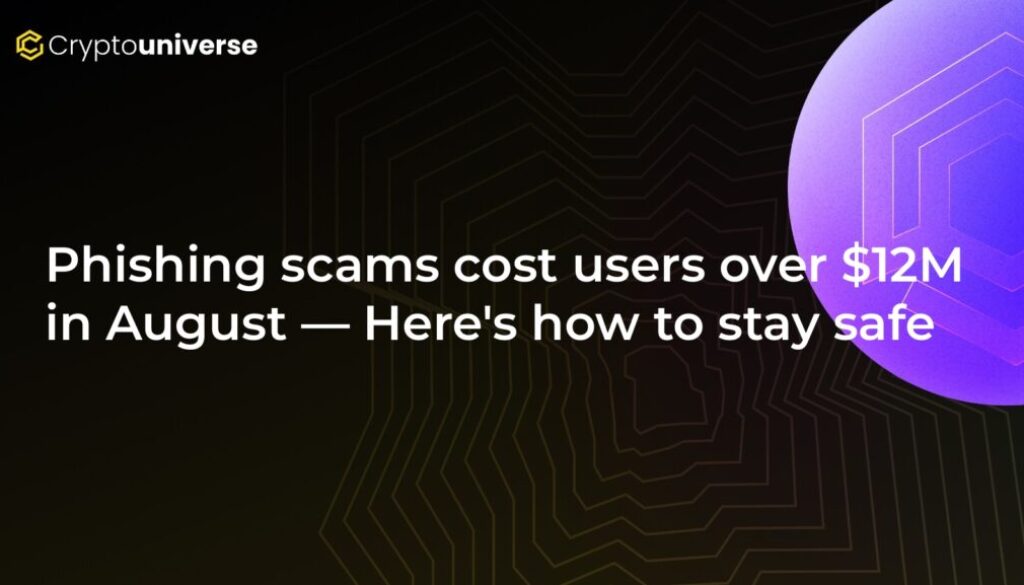Phishing scams cost users over $12M in August — Here’s how to stay safe

The Digital Gold Rush Has a Dark Side: Phishing Scams on the Rise
The world of cryptocurrency and Web3 is brimming with innovation and opportunity, but it also attracts a shadowy element. Malicious actors are constantly devising new ways to part unsuspecting users from their digital assets. August was a stark reminder of this reality, as
While phishing accounted for $12 million, the total amount stolen through various crypto hacks and exploits in August soared to over $163 million. This isn’t a problem reserved for whales or large institutions; scammers are increasingly targeting regular users, making vigilance more critical than ever.
August by the Numbers: A Sobering Look at the Data
According to a report from Web3 anti-scam service Scam Sniffer, the statistics for August are alarming:
- $12 Million Lost: Phishing attacks drained over $12 million from users, a staggering 72% increase compared to July.
- 15,230 Victims: The number of individuals impacted by these scams jumped by 67%, showing the wide net cast by attackers.
- A Devastating Single Loss: In one particularly brutal attack, a single user lost over $3 million to a phishing scam.
New Attack Vector: The Rise of EIP-7702 Scams
Scammers are not just reusing old tricks; they are actively exploiting new technological developments. The report noted a “sharp escalation” in scams related to EIP-7702. This Ethereum improvement proposal is designed to allow standard crypto wallets (Externally Owned Accounts) to function temporarily like more complex smart contract wallets.
While intended for innovation, hackers have twisted this functionality, using it to drain over $5.6 million in August alone through just three separate attacks. This demonstrates how quickly bad actors can weaponize new features in the ecosystem.
Anatomy of a Scam: How Phishers Bait Their Hooks
To protect yourself, you need to understand the enemy’s tactics. Phishing scams rely on deception and social engineering, often disguised as legitimate communications to trick you into revealing sensitive information.
1. The Impersonator
Scammers frequently pose as representatives from well-known cryptocurrency exchanges, wallet providers, or even government agencies. They create fake websites with URLs that are nearly identical to the real ones (e.g., `binnance.com` instead of `binance.com`) or send official-looking emails, text messages, and social media DMs.
2. The False Sense of Urgency
A classic tactic is to create panic. You might receive a message claiming your account has been compromised, is facing a security threat, or that you need to verify your identity immediately to avoid having your funds frozen. This urgency is designed to make you act rashly without thinking.
A recent, devastating $91 million hack used this very method. The attacker posed as ‘wallet support,’ convincing the victim to hand over critical information under the guise of helping them.
3. The SIM Swap Attack
One of the most invasive tactics is the SIM swap. A scammer tricks your mobile provider into transferring your phone number to a SIM card they control. Once they have your number, they can intercept password reset codes and bypass SMS-based two-factor authentication (2FA), giving them access to your crypto exchange accounts and more. Over $13 million has been stolen this way in recent months.
Your Ultimate Defense: A Guide to Fortifying Your Crypto Assets
Staying safe in Web3 is an active process. By adopting a security-first mindset and implementing the following measures, you can dramatically reduce your risk of becoming a victim.
1. Scrutinize Everything
- Check URLs Religiously: Before entering any information, double- and triple-check the website’s URL. Look for tiny misspellings or unusual domain extensions.
- Bookmark Trusted Sites: Instead of using a search engine every time, access your frequently used exchanges and platforms through bookmarks you have saved.
- Inspect Emails and Messages: Look for grammatical errors, misspellings, or an unprofessional tone. Legitimate companies rarely send emails filled with mistakes.
2. Never Share Your Secrets
This is the golden rule of crypto. NEVER, under any circumstances, share your seed phrase, private keys, or passwords with anyone. Legitimate support staff will never ask for this information. Your seed phrase is the master key to your entire wallet.
3. Upgrade Your Two-Factor Authentication (2FA)
While any 2FA is better than none, SMS-based 2FA is vulnerable to SIM swap attacks. Upgrade your security by using an authenticator app like Google Authenticator or Authy. For the highest level of security, consider using a physical security key (YubiKey).
4. Use a VPN
A Virtual Private Network (VPN) masks your IP address and encrypts your internet connection. This makes it harder for attackers to target you based on your location or monitor your online activity.
5. Isolate Your Assets
Don’t keep all your crypto in a single hot wallet (a wallet connected to the internet). For long-term holdings, use a hardware wallet (like a Ledger or Trezor). These devices keep your private keys offline, making them immune to online phishing and malware attacks.
Stay Vigilant, Stay Safe
The threat of phishing and other scams is a persistent challenge in the digital asset space. However, it’s not a reason to be discouraged. By understanding the tactics scammers use and proactively implementing strong security practices, you can navigate the world of Web3 with confidence. Treat your digital security with the same seriousness as your physical security, and you’ll be well-equipped to protect your hard-earned assets.


